Military Formation Flying in DCS: Your First Flight in the T-45 Goshawk.
So, you’ve got your wings (virtually speaking), strapped into the T-45C Goshawk, and your instructor’s voice crackles over the radio:
“Two, position left echelon, line astern let’s see what you’ve got.”

Welcome to military formation flying one of the most demanding, disciplined, and visually rewarding skills you’ll learn as a virtual naval aviator. In this flight, you’ll be Number Two, the wingman to your instructor, maintaining perfect position and stability as you fly in tight formation through the sky.
1. Introduction to Formation Flying
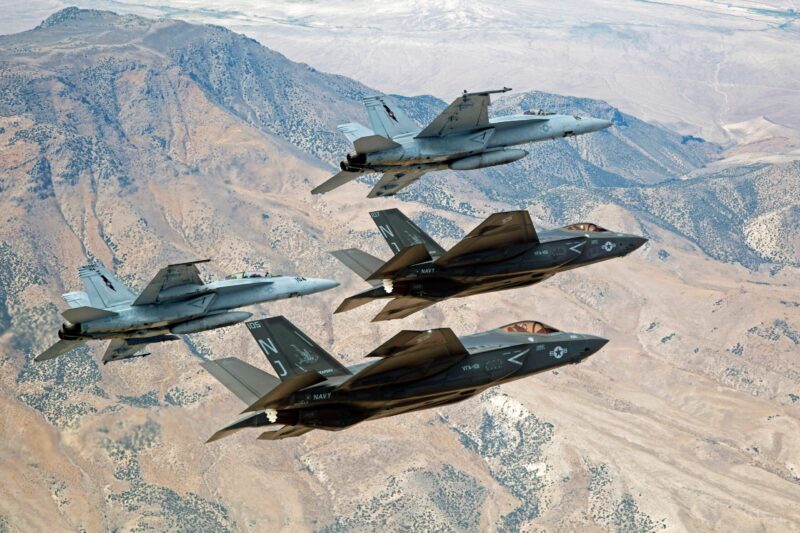
Formation flying is all about precision, trust, and consistency. In military training, it builds situational awareness, communication skills, and the ability to fly as one unit — essential for tactical operations, aerobatic displays, and carrier work.
What’s Required
Before even taking off, you’ll need:
- Smooth throttle and stick control — no jerky movements.
- Good trim discipline — your aircraft should fly hands-off stable.
- Clear radio comms — brevity and clarity are essential.
- Understanding of formation geometry — knowing where you belong in space relative to your lead.
You’re not flying your aircraft independently anymore; you’re flying off the lead aircraft, using visual references to maintain precise spacing.
Common Formation Types
In DCS (and in real military aviation), you’ll typically practice these standard formations:
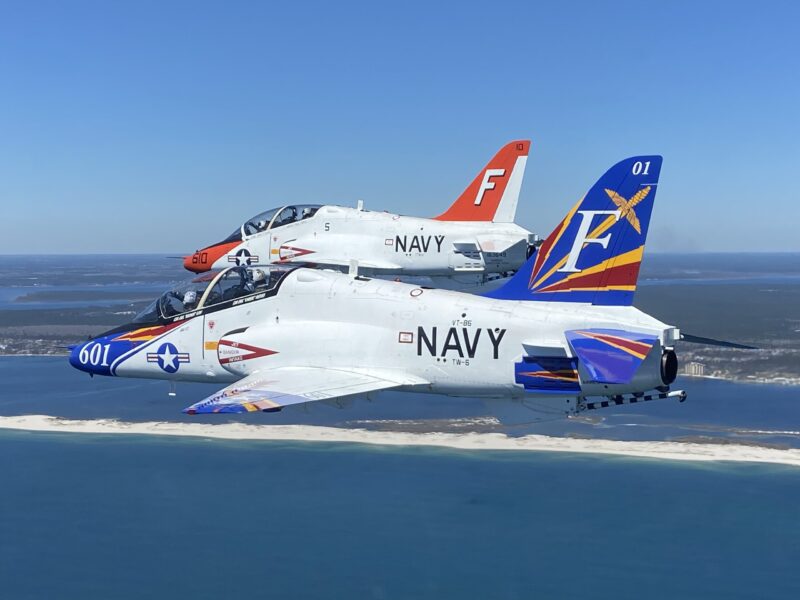
- Echelon Left/Right – Wingmen line up diagonally off the leader’s left or right wing, slightly aft and below.
- Line Abreast – Level with the leader, perfect for tactical awareness.
- Trail / Line Astern – One behind the other; excellent for formation turns and practice.
- Finger Four – The classic WWII and modern multi-ship tactical setup.
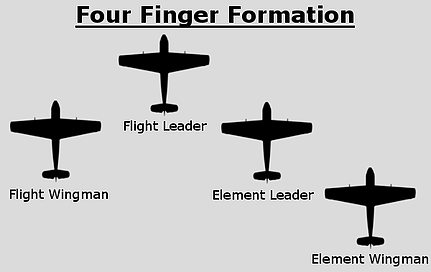
Each has its purpose — from parade displays to tactical positioning — but for training in the T-45, you’ll most likely be flying Echelon and Line Astern.
Position Parameters to Maintain
Formation accuracy is measured by relative position, not by instruments. You’ll use visual cues on the lead aircraft’s fuselage and canopy.
Typical tolerances for a student flight:
- Lateral (side) spacing: ±10 feet (roughly half a wingspan).
- Fore-aft (trail) spacing: ±10–15 feet.
- Vertical separation: ±5 feet (usually slightly below lead).
- Bank and pitch match: within ±5° of lead.
The goal? Hold position without chasing.
Make smooth micro-corrections think in “pressure,” not “movement.” If you’re correcting more than an inch of stick, you’re probably over-controlling.
What You Need to DO!
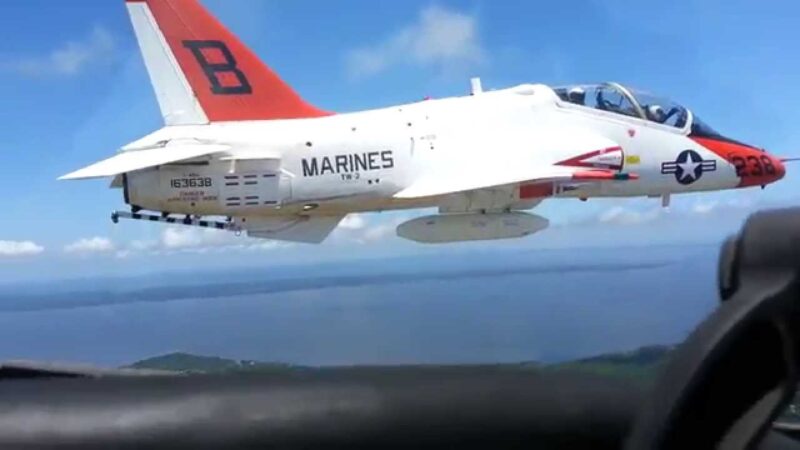
In the formation do your best to align yourself so when you see the leaders wing you only see the end and not the top or bottom. This aligns you in position Vertically and in my flights I kept the leader at 45 Degrees and inside the Left or right quarter inside my canopy.
Its very challenging and only after probably 10 flights am I starting to become more consistent. Far from passing a flight in my opinion.
TIPS:
Take off & Re-join
Starting with you flight leader taxiing out get up close and personal in trail. The leader does not wait for you so when they turn onto centreline the power comes up so make sure your in your position at 45 degrees to the rear.
OPTION 1 – Straight Out Departure: Roll with the leader and just do your best to stay on his wing or just behind. The take-off roll is excessively fast for the AI T-45 Goshawk (190 knots) and so I often took to the air at about 140-50 knots and remained just off the runway in ground effect.
You need to LOWER POWER a little to remain behind the leader. Once the AI is in the air power back up to maintain position. You have to stay close id the departure is straight out. Stay with the leader from initial roll.
CAUTION: If the flight plan calls for a climb to altitude at the next waypoint the T-45 AI Leader will make an abrupt climb one he has speed to do it. Be ready!
OPTION 2 – Take Off in Opposite direction to Flight Plan: Let the AI T-45 Goshawk start its roll and give it about 4-5 seconds before you start your roll!
What this does is give you time to cut across the circle if the lead jet turns and flies back downwind. Doing this means you can get on his wing by the time he’s back parallel with the runway.
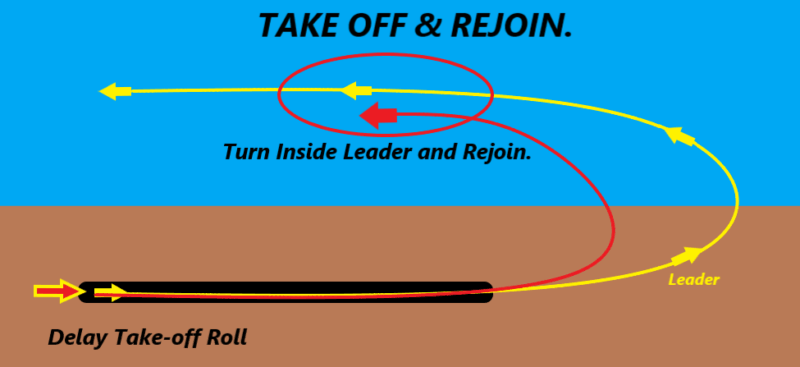
Passing the Flight (As #2)
To successfully complete this formation sortie, you’ll need to:
- Join up smoothly without overshooting lead. In position as quickly as possible.
- Stabilize in position within the above tolerances.
- Hold formation through basic turns and altitude changes. (Challenging)
- Maintain visual contact and smooth control inputs throughout.
- Respond promptly to lead’s commands and hand signals.
Your instructor will be looking for stability, precision, and composure – not aerobatic flair.
2. The T-45 Goshawk: Specs and History
The McDonnell Douglas (now Boeing) T-45C Goshawk is the U.S. Navy’s primary jet trainer, derived from the British BAE Hawk. It’s a single-engine, two-seat aircraft designed to prepare student aviators for carrier operations and tactical jet training.
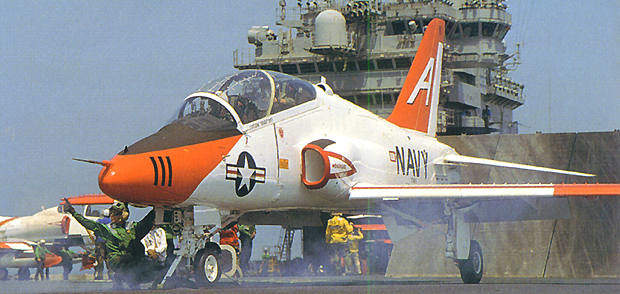
Quick Specs:
- Engine: Rolls-Royce Turbomeca F405-RR-401
- Thrust: ~5,845 lbf
- Top Speed: Mach 0.95 (~645 mph / 1,040 km/h)
- Ceiling: 42,500 ft
- Range: ~800 nm
- Crew: 2 (Instructor + Student)
- Carrier Capable: Yes – reinforced gear, arrestor hook, and approach power compensator
Introduced in the early 1990s, the Goshawk’s mission is to bridge the gap between basic flight training and advanced tactical jet platforms like the F/A-18 Hornet. In DCS, the Freeware T-45 mod by the community offers an impressively detailed and authentic recreation, making it perfect for structured naval training flights like this one.
Download T-45 Goshawk V 1.02 Mod Free
Next Step: The Flight Video
In the accompanying video, you’ll see me fly as Number Two in a two-ship T-45 formation. We’ll brief the flight parameters, visual cues, and power settings needed to stay locked in on the instructor’s wing from take off through turns and re-joins.
This session focuses on formation integrity and smoothness, not speed or aggression. Once you can hold formation confidently, you’re ready for advanced tactical and carrier approach training.
This took quite a few flights to get as smooth as I was in this mission. I aim to be much better and work especially on the turns which still need work.
INSERT VIDEO HERE
The Training Mission.
The DCS WORLD T-45 Formation training mission is downloadable HERE.
Simply download and copy the mission onto your mission folder.
The mission utilizes the Freeware Mod T-45 Goshawk and the Caucuses Map so other than downloading the freeware aircraft and placing it in your USERS/DCSWORLD/MODS/AIRCRAFT folder there is little else to do but fly.
Important: The AI T-45 Goshawk has a very shallow departure angle on take off and having more than 70 percent fuel means it normally crashes into the trees or a low building. I have the fuel set at 50% since this is a very short and fun mission and this seems to work in this scenario. If you wish to extend the mission and add fuel be aware the trees may get the AI if you add more than 70 percent.
Situation – Lets Fly.
You are parked engines running so as to save a little time. You are on the left side of the hardstand and the leader is at the far right end. The weather is variable so the leader may taxi down past you or taxi and go away from you to the other end of the runway due to weather. Watch the leader!
On take off the AI T-45 taxies out and nearly immediately starts his take off run. Although doing a formation take-off is adding additional challenge, I found it hard to coordinate.

There are advantages to waiting 5 seconds then following the leader as this will give you a realistic chance of seeing which way he turns after his in the air. This will allow you to then be able to cut the corner and get on his wing fast.
A good wingman should be on his leader in the shortest possible time! Pass this first test! Be on his wing ASAP. IF the departure is straight out you have to be quick to get on his wing. Its much more challenging and worth trying to fly a formation take off if you can.
Leader Turns toward you when he taxis then take off alongside if you can!
Leader Turns away from you and taxis then hurry to catch him and let him get airborne first and give him those 5 seconds to get into the air.
Your tasks are as follows:

- Take off and joint your leaders so fast he thinks you were there all the time!
- Remain on his wing 45 Degrees to his side level with his wing as a reference. If the wing is edge on your in the right spot and he is in your from 45 in the windscreen was my aim point.
- Remain in this position during climbs, descents and turns.
Landing.
I have chosen to follow the leader from the IP point in trail. The AI so far does not fly a full pattern. It goes from the 2000 ft to the approach at 900 ft then appears to fly the approach but then turns right and refiles the whole thing again.
I may edit the pattern so he remains at 1500ft and then maybe hell fly straight in and then do the break and land. This is a work in progress for me, Be aware the AI is a little erratic in the pattern ATM.
I hope to make this part more realistic so as to be able to fly into the break and do a full pattern to landing with the AI leader. Soon I hope.
Wrap-Up
Formation flying is the art of precision teamwork — and in DCS, it’s one of the most rewarding skills to master. The T-45 Goshawk gives you the perfect training environment: forgiving yet responsive, military yet accessible.
You’ll feel it the first time you lock into position, stable and smooth, the other jet perfectly framed against your canopy — that’s when you know you’ve started thinking like a real naval aviator.
Next Mission: Formation Turns and Re-joins — coming soon on LetsFlyVFR.com with full in-cockpit footage and commentary.
Download My Formation Mission Here!
(Note: Download the mission and unzip. WordPress does not allow LUA scripts to be uploaded. Please unzip this small file and place it in your missions and enjoy.)
Mission Available Now! All You need is DCS WORLD Caucuses Map and the T-45C Mod! You can fly this mission and more upcoming missions while learning to fly and fight as a STUDENT PILOT – Enjoy 🙂 Lets suite up!
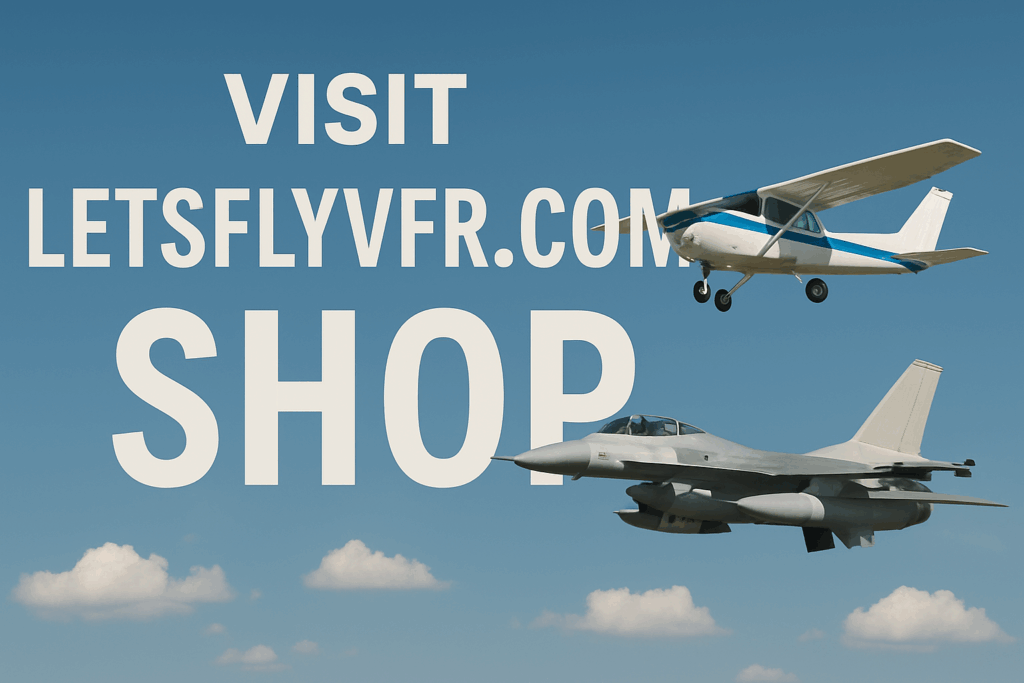
Author

Brendon McAliece (Aka Gunnie) is a military veteran with 23 years working on Jet Fighters, their weapons systems and ejection seat/module systems as well as munitions and R&D. Involved with flight simulation since the 1980s, he has flown all the major flight simulators over the years.
He is an Australian expat who has lived in Malaysia, UK, Saudi Arabia and more recently Thailand. He is a multi-lingual blogger who loves to share his life experiences here on LetsFlyVFR.com and DreamingGuitar.com, with his lifestyle and Travel experiences Blog plus his Dreaming Coffee website.
Learn More @
DreamingGuitar.com – DreamingCoffee.com – LetsFlyVFR.com
(HOME – BLOG – SHOP – ABOUT)
This page has been viewed 0 times.
As an Amazon affiliate I may benefit from qualifying sales.

Leave a Reply